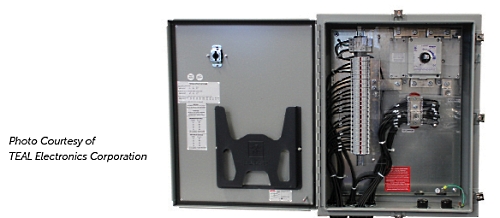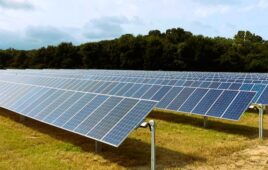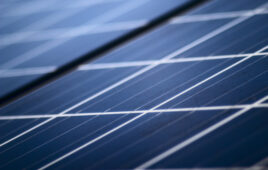 In a large solar photovoltaic (PV) array, multiple solar modules are connected in series in a string to build the voltage up to proper levels for the inverter. Multiple strings of solar modules are then combined together in parallel to multiply the string output currents to higher levels for input into the inverter.
In a large solar photovoltaic (PV) array, multiple solar modules are connected in series in a string to build the voltage up to proper levels for the inverter. Multiple strings of solar modules are then combined together in parallel to multiply the string output currents to higher levels for input into the inverter.
The combiner box is a device that combines the output of multiple strings of PV modules for connection to the inverter. It is typically used in the larger commercial and utility scale PV power plants (greater than 500kW). The combiner box commonly houses the input overcurrent protection fuse assemblies for several strings (from as few as three strings to as many as 52), as well as the combined bus of those inputs into a single main output. Today’s combiner box may also house several other components for the site, such as a DC disconnect, surge protective devices and, in some cases, string monitoring hardware.
There are several key elements to pay close attention to when specifying or evaluating a string combiner box. The first element is the enclosure. Most string combiners are available in outdoor-rated enclosures, typically NEMA 3R, 4 or 4X, with NEMA 3R being the minimum requirement. More typical today is a NEMA 4 steel or NEMA 4X non-metallic enclosure. In high humidity areas, or areas with a large swing in humidity, you might consider adding a condensation or breather vent that will allow pressure equalization to the enclosure, but prevent water molecules from entering it.
The enclosure is often one of the more expensive components in the string combiner but it’s important because it has a direct impact on the life of the combiner. The enclosure’s mounting position, size and color directly affects the internal temperatures. Lighter colors typically absorb less solar radiation than darker colors.
Mounting on a north facing wall in the shade is recommended, as direct sunlight can significantly increase internal combiner temperatures, reducing reliability and life of internal components. Size can also have an impact. Comparing two combiner designs with the same internal components, the combiner in the larger enclosure allows the larger air volume and surface area inside the enclosure to assist in better cooling of internal components. Smaller is not better for long string combiner life. Larger enclosures also make field wiring easier by allowing more room to work during installation and maintenance.
Output wire bend radius is another element to pay close attention to when specifying or evaluating a string combiner box. The NEC and UL have requirements for wire bend radius spacing inside a string combiner. There are both opposite wall and adjacent wall bend radius requirements that are determined by the size of the terminal or lug that your output wire is landing to. Larger lugs require more space. In the larger utility scale PV sites, many installers choose to use aluminum conductors for the large gauge output wires from the combiner to the inverter due to aluminum cost being much less than copper—especially when dealing with hundreds of feet of conductor. However, the aluminum conductor requires a larger gauge than the equal length copper for similar voltage drop, which requires larger terminals or lugs inside the combiner. This drives the requirement for longer bend radius, and consequently a larger combiner enclosure. Bending the large conductors in the field is time consuming and often wastes material, so using a combiner design that enables a straight shot to the output terminal without a bend can save installation time and reduce mechanical stress on components inside the string combiner.
One final item to note in the string combiner is a proper long-term maintenance plan. Monitoring and maintaining the electrical connections can help insure a high reliability and long lasting field installation.
By: Kevin Harris, Marketing Manager and Renewable Energy Product Manager at TEAL Electronics Corporation




We could not get an output from the combiner having Three strings of PVs. What is possibly the fault